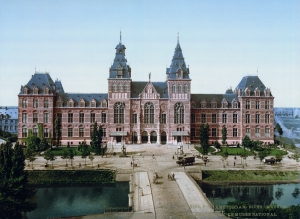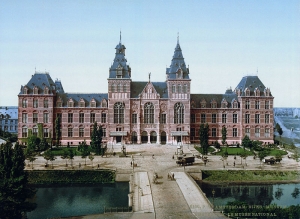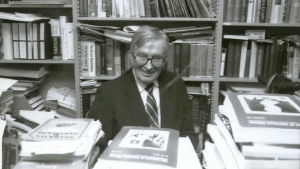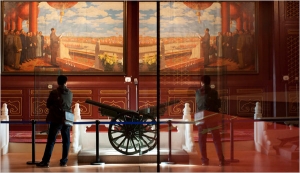|
Displaying items by tag: History

While many museums post photos of their illustrious collections online, the images are not for public use. The Rijksmuseum in Amsterdam is about to change all of that. The institution, which focuses on the art and history of the Netherlands, is allowing visitors to download high-resolution images off of their website at no cost. They’re even going so far as to encourage patrons to copy, alter, and share the images.
The Rijksmuseum, whose collection includes works by Rembrandt (1606-1669), Johannes Vermeer (1632-1675), Piet Mondrian (1872-1944), and Vincent van Gogh (1853-1890), has already made 125,000 images available through Rijksstudio, an interactive section of their website. Officials aim to add 40,000 images per year until the entire collection, which is comprised of 1 million artworks, is available to the public. The decision to make all of the museum’s images public stems from the notion that they are a public institution, making the art and objects in their collection communal property. The proliferation of the Internet has also made image policing extremely difficult and officials would rather the public use high-quality images instead of poor reproductions.
Rijkstudio has seen over 2.17 million visitors since going live in October 2012 and approximately 200,000 people have downloaded images.

Officials at the Rijksmuseum in Amsterdam announced that the museum will reopen to the public on April 14, 2013. The Rijksmuseum, a Dutch national institution devoted to arts, crafts, and history, has been closed for 10 years as part of a massive renovation and modernization project.
The museum is currently working to reinstall around 8,000 masterpieces from the national collection spanning from the Middle Ages to present day. While the Rijksmuseum’s main building was closed, the institution sent a selection of 400 works, including their most famous painting, Rembrandt’s (1606-1669) The Night Watch (1642), to the Philips Wing, a previously renovated “fragment building” belonging to the museum. The works formed a major exhibition titled Masterpieces of the Dutch Golden Age, which saw approximately 1 million visitors during its run.
The Rijksmuseum renovation cost approximately $481 million to complete and included restoring all eighty of the museum’s galleries with their original decorations and paintings as well as implementing the most up-to-date technologies and applications. The project was expected to reach completion in 2008, but a series of contractor issues and planning problems delayed progress.
Museum officials expect attendance to increase significantly after the institution reopens; prior to the Rijksmuseum’s closure, it saw approximately 1 million visitors each year. The museum is also planning to stay open 365 days a year, which would make it the first national museum in the world to be open every day.

The Oakland Museum of California, which is devoted to the art, history, and natural science of California, was been burglarized for the second time in two months on Monday, January 7, 2013. During the first robbery, the thief made off with a number of objects and pieces of gold that were on view as part of an exhibition about California’s Gold Rush. This week, a thief stole a significant gold and quartz box from the same exhibition. The box, which features elaborate decorations depicting early pioneer life, could be worth as much as $800,000.
Officials believe that the most recent break-in was pre-meditated and that the burglar pinpointed specific items to steal, making their way in and out of the museum very quickly. Security camera footage confirms that the thief worked alone. Both recent burglaries occurred on Mondays, when the Oakland Museum is closed to the public. Officials are investigating whether or not the two crimes are connected.
A $12,000 reward is being offered for the safe recovery of the box, which officials fear could be melted down for its materials.

Historian and American decorative arts expert, Wendell D. Garrett, died of natural causes on November 14 in Williston, Vermont. He was 83. Garrett was well known for his appearances as an appraiser on the PBS series, “Antiques Roadshow,” which launched in 1997. Garrett participated in every season of the program and will make a posthumous appearance on the show’s next season, which premieres January 7, 2013.
Prior to his work on “Antiques Roadshow,” Garrett served as the senior vice president in the American decorative arts department at Sotheby’s. He also wrote and edited a number of books on antiques including Victorian America: Classical Romanticism to Gilded Opulence (1993), Monticello and the Legacy of Thomas Jefferson (1994), and American Colonial: Puritan Simplicity to Georgian Grace (1995).
Born in Los Angeles in 1929, Garrett attended UCLA where he earned a bachelor’s degree in history. Subsequently, Garrett enrolled at the University of Delaware and received a master’s degree in early American culture from the school’s distinguished Winterthur program. He later earned another master’s degree in American history from Harvard.
Garrett joined the Adams Papers Project at the Massachusetts Historical Society in 1959 where he served as the assistant editor of the Diary and Autobiography of John Adams (1961), a four-volume set that starts with entries from 1755. Garrett is also credited with finding an even earlier Adams diary with entries beginning in 1753. The Earliest Diary of John Adams was published in 1966 with Garrett as associate editor.
Garrett’s three children, four grandchildren, and a brother survive him.
Philadelphia is home to the nation’s first medical library, hospital, and surgical amphitheatre, its first medical school, first children’s hospital, and first college of pharmacy. In a celebration of the intersection of medicine and art, the 2012 Philadelphia Antiques Show (April 28–May 1, 2012) Loan Exhibition showcased the exceptional fine art and objects that have been part of Pennsylvania Hospital’s 260 years of history. Established to care for the sick poor and mentally ill in 1751, Pennsylvania Hospital, still fully-operational, was the nation’s first chartered hospital and is a repository of antique furniture, paintings, sculpture, rare books, and manuscripts linked to its history. Over fifty objects from or related to the Pennsylvania Hospital were on display at the antiques show, and included:

At the elaborately renovated National Museum of China in Tiananmen Square, visitors interested in the recent history of the world’s fastest rising power can gaze at the cowboy hat that Deng Xiaoping once wore when he visited the United States, or admire the bullhorn that President Hu Jintao used to exhort people to overcome hardship after the Sichuan earthquake in 2008.
But if their interests run to the Cultural Revolution that tore the country apart from 1966 to 1976 and resulted in millions of deaths, they will have to search a back corner of the two-million-square-foot museum, which will complete its opening this month, for a single photograph and three lines of text that are the only reference to that era.
China spent more than a decade and nearly $400 million to remake the National Museum into a leading showcase of history and culture, a monument to its rising power no less grand — it is designed to be the world’s largest museum under one roof — and more enduring than the Olympic Games it hosted in 2008.
But one tradition has remained firmly in place: China will not confront its own history. The museum is less the product of extensive research, discovery or creativity than the most prominent symbol of the Communist Party’s efforts to control the narrative of history and suppress alternative points of view, even those that exist within the governing elite. It is also an example of how China finds it difficult to create cultural institutions that prove equal to its economic achievements.
Interviews with participants describe a tortured reconstruction that dragged on years longer than envisioned, with plans constantly revised to accommodate political twists and turns, many decided personally by top party leaders.
Officials rejected proposals for a permanent historical exhibition that would have discussed the disasters of early Communist rule — especially the Great Leap Forward, a political campaign and resulting famine that killed more than 20 million. Some organizers also wanted a candid appraisal of the Cultural Revolution, a decade-long attack on traditional culture and learning, but that effort was squashed.
|
|
|
|
|